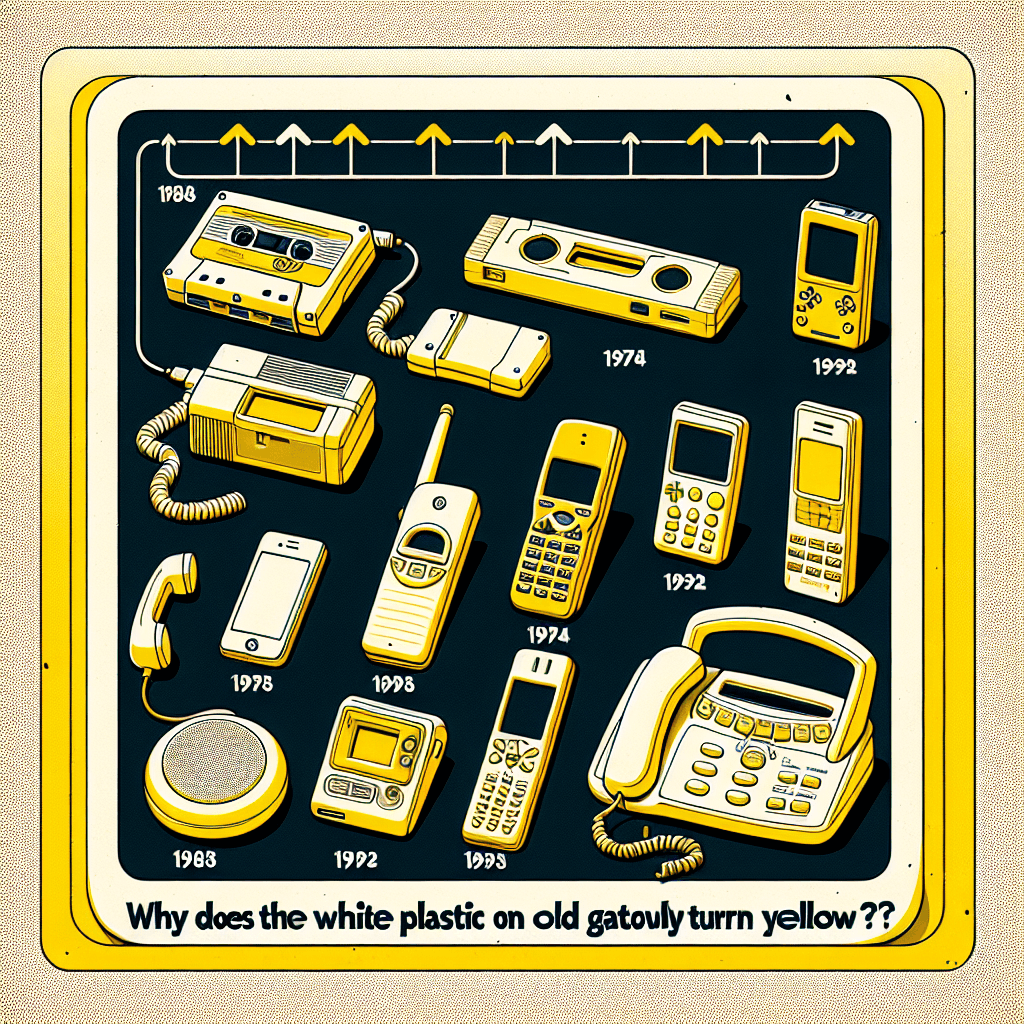Why does the white plastic on old gadgets slowly turn yellow
The very chemical added to protect your old gadgets from fire is the secret culprit behind their unsightly yellowing over time.


Too Long; Didn't Read
TLDR: The flame retardant chemicals mixed into the plastic break down when exposed to UV light and heat over time, causing the surface to turn yellow.
The Retro-Not-So-Chic Phenomenon: Why Does White Plastic on Old Gadgets Slowly Turn Yellow?
Have you ever unearthed a treasured piece of vintage tech from your attic—perhaps an original Nintendo Entertainment System, a classic Macintosh computer, or an old-school VCR—only to find its once-brilliant white casing has turned a sad, dingy shade of yellow? You might assume it's just years of accumulated dirt or nicotine stains, but the truth is far more scientific. This common aging process isn't a sign of neglect; it's a chemical reaction happening right on the surface of the plastic. This blog post will delve into the fascinating chemistry behind why the white plastic on old gadgets slowly turns yellow, revealing the culprits hidden within the material itself.
The Main Culprit: What is ABS Plastic?
To understand the yellowing, we first need to look at the material most gadgets from the 1980s, 90s, and early 2000s were made from: Acrylonitrile Butadiene Styrene, or ABS plastic.
ABS was a wonder material for its time. It was strong, lightweight, resistant to impact, and relatively inexpensive to produce. Its ability to be easily injection-molded into complex shapes made it the perfect choice for the burgeoning consumer electronics industry. From computer keyboards and monitor housings to video game consoles and kitchen appliances, if it was a durable, hard-shelled plastic product from that era, it was likely made of ABS. However, this popular material had a hidden vulnerability that would only reveal itself over time.
The Science of the Yellow: Bromine and UV Light
The primary reason for the yellowing of ABS plastic is not dirt, but a chemical reaction triggered by exposure to ultraviolet (UV) light. The two key ingredients in this unfortunate transformation are the plastic polymer itself and a specific additive mixed into it.
The Fire Safety Additive
In the interest of safety, electronics manufacturers were required to make their plastic casings fire-resistant. To achieve this, they mixed brominated flame retardants (BFRs) into the ABS plastic resin. These compounds are very effective at inhibiting combustion, significantly reducing the risk of a device catching fire due to an electrical fault. The irony is that this safety measure is the main cause of the aesthetic degradation.
The Chemical Breakdown
Here’s a simplified step-by-step breakdown of what happens at a molecular level:
- UV Exposure: When the plastic is exposed to UV light—either from direct sunlight or even the fluorescent lights in an office—the high-energy light waves start to break down the chemical bonds within the ABS polymer.
- Bromine Instability: This UV energy also destabilizes the brominated flame retardant molecules mixed into the plastic.
- Oxidation on the Surface: The unstable bromine atoms migrate to the surface of the plastic. Once there, they react with the oxygen in the air in a process called oxidation.
- Color Change: This oxidation process creates new molecules on the plastic's surface known as chromophores. Chromophores are a chemist's term for the parts of a molecule responsible for its color. In this case, the specific chromophores formed absorb light in the blue spectrum, causing our eyes to perceive the surface as yellow or brownish.
Essentially, the very element added to protect the device from fire is what ultimately causes its cosmetic downfall when exposed to light and air.
It's Not Just Sunlight: Other Factors at Play
While UV light is the primary catalyst, other environmental factors can accelerate the yellowing process:
- Heat: High temperatures can speed up almost any chemical reaction, including the breakdown and oxidation of the ABS plastic. A console left in a hot attic or near a sunny window will yellow much faster than one kept in a cool, dark place.
- Oxygen: Since oxidation is a key part of the process, the presence of oxygen is necessary. However, as it’s a constant in our atmosphere, it’s an unavoidable part of the equation.
Turning Back Time? The "Retrobrighting" Solution
For vintage tech enthusiasts, this yellowing is a common frustration. This has led to the rise of a DIY restoration community built around a process often called "Retrobrighting." Hobbyists use a chemical solution, typically a hydrogen peroxide-based gel or cream, and apply it to the yellowed plastic. The item is then exposed to a UV light source (like the sun or a UV lamp). This process effectively reverses the oxidation, breaking down the yellowed chromophores and restoring the plastic to its original color.
However, Retrobrighting is not a permanent fix. Since it doesn't remove the bromine from the plastic, the yellowing will eventually return with further UV exposure. Furthermore, some studies suggest the process can make the plastic more brittle over the long term.
Conclusion
The yellowing of your old electronics is not a stain but a visible scar of time, written in the language of chemistry. It’s the result of a well-intentioned safety feature—brominated flame retardants—reacting with the environment, particularly UV light. This slow, steady transformation is a testament to the materials science of a bygone era. So, the next time you see a yellowed vintage gadget, you'll know it's not a sign of a dirty past, but rather a fascinating chemical story unfolding on its surface, a true patina of age.
More Articles

Why do we feel an urge to touch a surface that has a wet paint sign?
That irresistible urge to touch the wet paint isn't a lack of self-control; it's a fascinating psychological battle between obedience and your brain's deep-seated need to test reality for itself.

How does a simple glow stick produce light without batteries or heat?
It's not magic, it's a brilliant chemical reaction trapped in a tube; discover how that satisfying 'snap' unleashes a cascade of cold light without a single spark or battery.

Why does reading the word GREEN written in red ink short-circuit your brain?
It's a simple test that creates an instant traffic jam in your brain, pitting what you *read* against what you *see*. We'll uncover the science behind this cognitive clash and why one part of your brain almost always wins the fight.